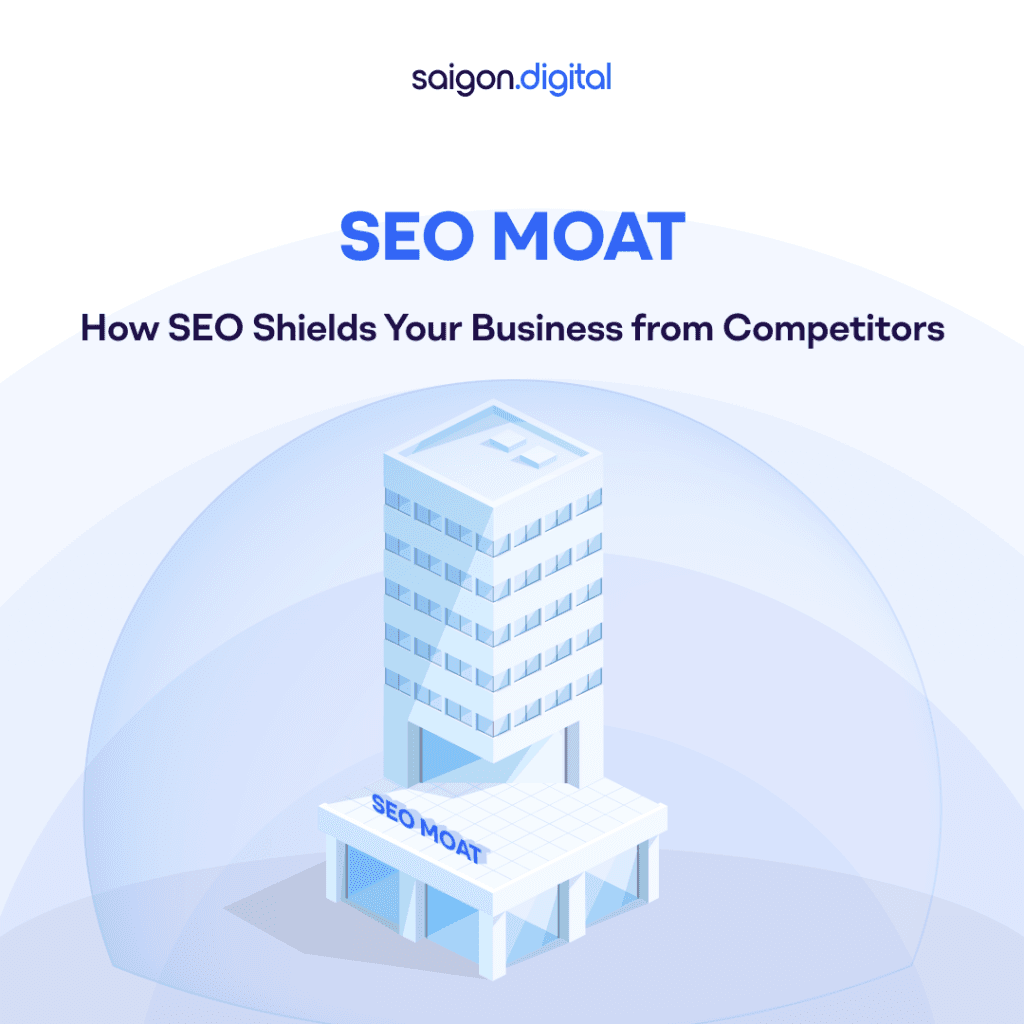
What Is an SEO Moat?
An SEO moat refers to the protective advantage your business gains through a strong, established search engine presence. It’s not just about ranking for keywords, it’s about creating defensive layers of content, authority, backlinks , and technical optimisation that make it extremely difficult for new or existing competitors to outrank you. The term borrows from Warren Buffett’s “economic moat” concept, referring to the unique advantages that prevent rivals from eating into your market share. But instead of pricing power or patents, your SEO moat comprises domain authority, topical relevance, trusted content, and search engine trust.Why SEO Acts as a Defensive Moat
Unlike short-lived marketing tactics like paid ads or influencer partnerships, SEO compounds over time. With a strong content infrastructure, consistent optimisation, and a solid backlink profile, your website becomes increasingly resistant to disruption. Here’s how SEO shields your business from competitors:Compounding Authority
Once your site has established domain authority through quality backlinks and consistent content, search engines begin to treat your domain as trustworthy. Google tends to favour established authorities, making it harder for newcomers to outrank you, unless they match your effort consistently over a long period. Example : HubSpot has built a massive SEO moat in the digital marketing niche. Through years of consistent publishing and link-building, their content dominates SERPs for thousands of high-value keywords. For a new competitor, it would take years of effort to even dent that visibility.Content Depth and Topical Coverage
Search engines increasingly reward websites that cover topics comprehensively. When your business owns a niche by publishing pillar content and supporting cluster articles, your site becomes a definitive resource. This “topical authority” means even if a competitor writes a similar piece, Google may still prefer your content. Example : A legal firm specialising in property law could build an SEO moat by publishing in-depth guides on leaseholds, freeholds, conveyancing, and property disputes. By doing so, they establish themselves as the definitive online authority in their niche.User Trust and Behavioural Signals
Once users begin to trust your brand and content, they engage more deeply, longer dwell times, lower bounce rates, and repeat visits. These behavioural signals tell search engines that your site is satisfying user intent, reinforcing your rankings.Backlink Equity
Quality backlinks are among the most valuable assets in SEO . If your site accumulates inbound links from reputable sources, it sends a strong authority signal to search engines. Competitors may struggle to replicate this naturally built profile, especially if your links come from earned media, academic journals, or government domains.The Building Blocks of an SEO Moat
Now that we understand the defensive power of an SEO moat, let’s delve into how to build one. Constructing a robust SEO moat requires strategic effort across several key pillars:Technical SEO Foundation
Think of this as laying the groundwork of your fortress. A website with a good technical SEO is fast, crawlable, mobile-friendly, and secure.- Use a clean URL structure
- Optimise site speed and mobile responsiveness
- Fix crawl errors and broken links
- Implement schema markup for rich results
- Ensure secure HTTPS protocols
Authoritative Content Strategy
The heart of your moat is your content. But not just any content, valuable, original, and relevant material that directly answers your audience’s questions.- Use a topic cluster model with pillar pages and related blog posts
- Regularly update content to reflect the latest data or changes
- Include multimedia (videos, infographics) to increase engagement
- Optimise for both humans and search engines (think E-E-A-T: Experience, Expertise, Authoritativeness, Trustworthiness)
Strategic Link Building
Earned backlinks from reputable websites are the strongest signals of trust to search engines.- Guest post on relevant, high-authority websites
- Create link-worthy assets like research studies, calculators, or data visualisations
- Leverage digital PR to get featured in news outlets
- Use HARO (Help A Reporter Out) to provide expert commentary in exchange for backlinks
User Experience and Engagement
Google is increasingly factoring UX metrics into its ranking algorithm. A satisfying user experience helps reinforce your SEO moat.- Make content easy to read (use headers, bullet points, short paragraphs)
- Optimise navigation for seamless browsing
- Reduce page load times
- Use internal linking to guide users and boost site depth
How to Sustain Your SEO Moat Over Time
Building an SEO moat is only half the battle. Sustaining it requires ongoing maintenance and adaptation:Content Refresh Strategy
Google rewards fresh, accurate content. Periodically revisit older articles to update statistics, refine language, and improve structure. Or if you find yourself not being able to update your catalog that often, you can consider creating evergreen content , this way your content has more staying power than your usual trends articles.Competitor Monitoring
Keep an eye on competitors who may try to breach your moat. Use SEO tools like Ahrefs or SEMrush to track new keyword rankings, content gaps, and backlink strategies. It’s also recommended to continuously perform competitor analysis . This not only provides you with updated insights regarding what they’re doing in terms of SEO but also to guard against any potential outranking on their end.Expand Into Adjacent Topics
Once your niche is defensible, consider branching into related keywords. This expands your digital footprint and strengthens your overall authority. Example: A fitness blog with strong rankings on strength training could expand into nutrition, supplements, or recovery methods to capture broader audiences.Invest in Brand Signals
Google increasingly factors in brand recognition as a ranking signal. As your brand becomes a known entity, users search for you by name, which further boosts your perceived authority.- Build a presence on social media
- Encourage branded searches through email marketing and content
- Foster brand mentions on external sites, even without links
The Long-Term Value of an SEO Moat
When done right, an SEO moat can serve as your most valuable digital asset. It delivers long-term ROI by driving:- Consistent organic traffic without ad spend
- Lower customer acquisition costs
- Higher profit margins due to compounding visibility
- Increased brand credibility and trust





